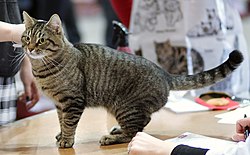European Shorthair
Breed of cat From Wikipedia, the free encyclopedia
The European Shorthair, also known as the European [4] and Celtic/European Shorthair,[5] is a pedigreed cat breed. The breed's name has also been used to describe the landrace domestic cat of Europe, causing confusion as the pedigreed cats of this breed also should resemble the typical domestic cats of Europe.
This article needs additional citations for verification. (February 2021) |
The role as the cat breed resembling the original domestic cats of Europe was held until the beginning of the 20th century by the British Shorthair, even though stockier than the majority of common European cats, until 1949 when the European Shorthair was recognized by the Fédération internationale féline (FIFe). The oldest known European Shorthair registered in FIFe was born in 1940.[citation needed]
History
Origin
European Shorthair has its counterparts in Great Britain (British Shorthair) and the U.S. (American Shorthair), though these breeds have been bred for longer. The British Shorthair, however, was crossed with the Persian and selectively bred to become a cobbier cat with a slightly shortened muzzle and thicker coat.[6] It was confusing for Scandinavian breeders that the British Shorthair was also called European Shorthair at that time, even though it looked different. Felinological associations recognized both types of cat as a single breed, meaning they were judged by the same standards during cat shows, until 1982 when FIFE registered the Scandinavian type of European Shorthair as a separate breed with its own standard.[7]
Breed recognition
As of 2023, the European (Shorthair) cat breed is recognised by ACF, FIFe, LOOF, TICA (registration only), and WCF.[8][9]
Appearance
Black, white, and cream tabby European Shorthairs
The breed resembles a domestic shorthair and is of medium size with a muscular body. The face is well rounded with well developed cheekbones. The ears are of medium size and slightly rounded at the tip. Eyes are round and open. The eye can be any colour including odd eyed. The neck is of medium length and muscular. The tail is of medium length, thick at the base with a rounded tip.

Coat
The European Shorthair's coat is short, dense, and glossy.[10]
Coat Colour
All natural colours are permitted, such as black, red, blue and cream, with or without tabby, tortoiseshell, silver or white markings, though the combination of tabby with white and smoke with white is not allowed in FIFe.[10] Solid white is also permitted. The eye colour corresponds to the coat colour and may be yellow, green or orange. Blue or odd-eyed individuals are permitted if the coat colour is white.[10][11]
Health
In a review of over 5,000 cases of urate urolithiasis in the US the European Shorthair had the highest rate of the condition with 53 cats having the condition out of a population of 78.[12]
Temperament
The breed has developed from the natural mouse hunters of Europe with the wish to strengthen the most desirable personality traits of the domestic cats. Most European Shorthairs are strong and active, and they are generally friendly towards people of all ages. They get on well with other cats and tolerate dogs well. European Shorthairs are intelligent and playful, and most of them are adept at keeping houses and gardens free of all types of rodents.[13]
Popularity
The breed is mostly popular in Scandinavia but also in Germany, as there are still huge populations of similar-looking cats in Europe, and the European Shorthairs are for those appreciating a supple breed which has had a selection for a good temper. The European Shorthair is on the list of endangered breeds in Sweden and is the national cat of Finland.[14][citation needed]
Gallery
- Blue mackerel tabby female
- Calico female
- A brown/golden tabby
- A silver/grey tabby
- A black male with green eyes
See also
References
External links
Wikiwand - on
Seamless Wikipedia browsing. On steroids.









